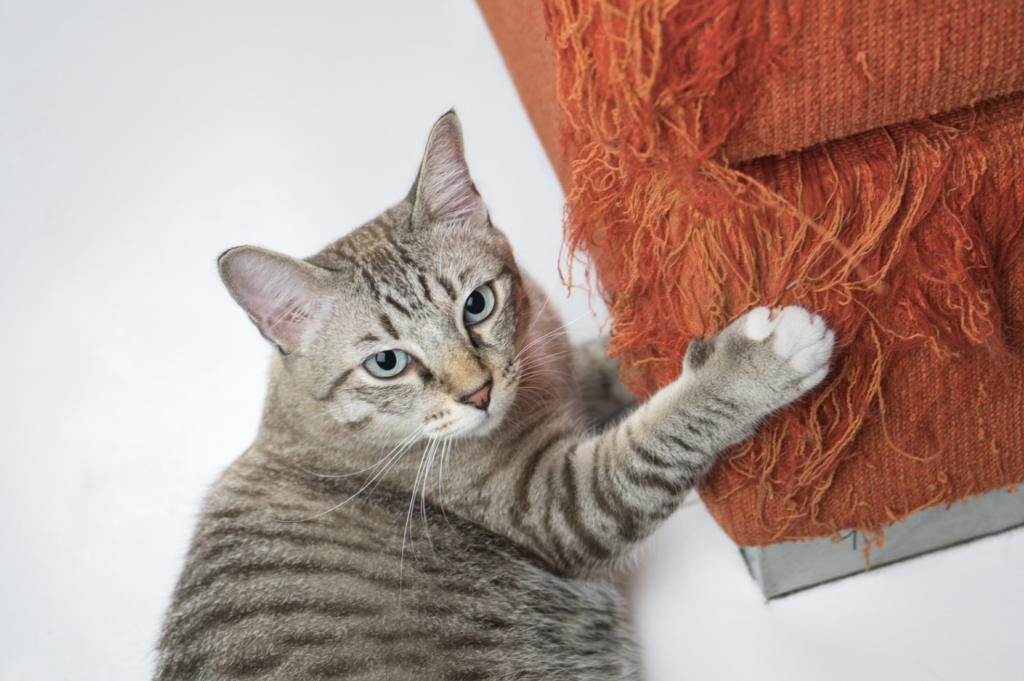How to Stop Your Cat from Scratching Furniture: Effective Tips and Solutions

If you’re a cat owner, you’ve probably experienced the frustration of finding your beloved furniture scratched and frayed. Cats scratch furniture not to annoy us but to fulfill their natural instincts. They scratch to mark territory, stretch their muscles, and keep their claws healthy. While this behavior is natural and necessary, it can become a problem when your sofa, carpets, or other furniture are the target. Thankfully, there are ways to stop your cat from scratching your furniture without discouraging this essential behavior.
In this guide, we’ll explore how to stop your cat from scratching furniture with practical tips and effective solutions that both you and your cat will appreciate.
1. Understand Why Cats Scratch
Before tackling the problem, it’s important to understand why cats scratch furniture. Scratching is an instinctual behavior for cats that serves several purposes:
- Marking Territory: Cats have scent glands in their paws. When they scratch, they release pheromones that mark their territory. This behavior is especially common in multi-cat households.
- Exercise and Stretching: Scratching helps cats stretch their muscles, particularly their back, shoulders, and paws. It’s also a way for them to relieve stress or pent-up energy.
- Claw Maintenance: Scratching removes the outer sheath of a cat’s claws, helping them stay sharp and healthy. It also promotes good circulation in their paws.
Once you understand why your cat is scratching, you can take steps to redirect this behavior in a healthy, constructive way.
2. Provide Alternatives: Scratching Posts and Pads
The most effective way to stop your cat from scratching furniture is to provide them with an appropriate alternative. Scratching posts and scratching pads are designed to satisfy your cat’s scratching instincts without damaging your home.
- Choosing the Right Scratching Post: Make sure the scratching post is tall and sturdy enough for your cat to fully stretch. Cats prefer posts made of sisal, carpet, or wood because they provide the resistance they need. The post should also be stable; if it wobbles or falls over, your cat may avoid it.
- Scratching Pads and Boards: Flat scratching pads or boards are great for cats that prefer to scratch horizontally. These can be placed on the floor, in areas where your cat already enjoys scratching.
- Multiple Options: Place multiple scratching posts or pads throughout your home, especially near the furniture your cat likes to scratch. This will make it easy for your cat to choose a more appropriate spot.

Check Also : Top 10 Questions Asked By Cat Owners: A Comprehensive Guide To Feline Care
3. Use Positive Reinforcement
Training your cat with positive reinforcement is key to stopping unwanted scratching behavior. Cats are more likely to repeat behaviors that result in rewards, so offering praise, treats, or playtime when they use the scratching post can help them associate it with positive outcomes.
- Rewarding Good Behavior: Whenever you see your cat using the scratching post or pad, immediately reward them with a treat, toy, or verbal praise. The more you reinforce the desired behavior, the more likely they are to use the scratching post consistently.
- Redirecting Scratching: If you catch your cat scratching the furniture, gently redirect them to the scratching post. Once they start using it, reward them to reinforce the behavior.
- Consistency is Key: Be consistent with your rewards and redirection. Over time, your cat will learn that the scratching post is the right place to scratch and will be less likely to go after your furniture.
4. Deter Scratching on Furniture
While providing alternatives is important, deterring your cat from scratching the furniture is also necessary. Cats are creatures of habit, so breaking the cycle of furniture scratching may require a combination of deterrents.
- Use Double-Sided Tape: Cats dislike the sticky texture of tape. Apply double-sided tape to the areas of furniture where your cat frequently scratches. This creates an unpleasant surface for them, discouraging the behavior.
- Furniture Protectors: Consider using furniture protectors or plastic covers on the edges of your furniture. These protectors make it difficult for your cat to get a good grip, discouraging scratching.
- Scent Deterrents: There are cat-safe sprays available that use scents cats find unpleasant, such as citrus or eucalyptus. Spraying these on your furniture can help deter your cat from scratching. Be sure to test the spray on a small area of your furniture first to ensure it doesn’t damage the fabric.
5. Keep Your Cat’s Claws Trimmed
Trimming your cat’s claws regularly can help reduce the damage they cause to furniture. Shorter, blunt claws are less likely to snag on fabric and cause tears.
- How to Trim Your Cat’s Claws: Use a pair of cat-specific nail clippers to carefully trim the tips of your cat’s claws. Be sure to avoid the quick—the pink part inside the claw where nerves and blood vessels are located. If you’re unsure how to do this safely, ask your veterinarian or a professional groomer for guidance.
- Soft Claw Covers: Another option is to use soft claw covers that can be applied to your cat’s nails. These covers are non-toxic, come in various sizes, and last for about four to six weeks. They prevent your cat from scratching furniture while still allowing them to perform their natural behaviors.
6. Encourage Play and Mental Stimulation
Sometimes, cats scratch furniture out of boredom or frustration. Providing enough playtime and mental stimulation can help reduce destructive scratching behavior.
- Interactive Toys: Engage your cat with interactive toys, such as feather wands, laser pointers, or puzzle feeders. This helps expend their energy and reduces the likelihood of them seeking out furniture to scratch.
- Scheduled Play Sessions: Set aside time each day to play with your cat. This not only strengthens your bond but also tires them out, making them less likely to engage in destructive behaviors like scratching.
7. Use Catnip or Pheromone Sprays
Catnip and pheromone sprays can be useful tools for encouraging your cat to use their scratching post instead of your furniture.
- Catnip: Sprinkle or rub a small amount of catnip on the scratching post to attract your cat to it. Many cats find catnip irresistible and will be drawn to the area where it’s applied. Just be mindful that not all cats respond to catnip.
- Pheromone Sprays: Synthetic pheromone sprays, such as Feliway, mimic the natural pheromones cats release when they feel safe and calm. These sprays can help reduce stress and anxiety, which may contribute to unwanted scratching. Use pheromone sprays around your home, especially near the scratching post, to encourage positive behavior.
8. Avoid Declawing
Declawing is a surgical procedure that involves the removal of the last bone of each toe. This practice is highly discouraged by veterinarians and animal advocates due to the pain and potential long-term health problems it causes for cats. Instead of declawing, use the humane methods outlined in this article to manage scratching behavior.
Conclusion
While scratching is a natural and necessary behavior for cats, it doesn’t mean your furniture has to suffer. By providing proper scratching alternatives, using positive reinforcement, and applying deterrents, you can help redirect your cat’s scratching to appropriate areas. Remember, the key to stopping your cat from scratching furniture is patience, consistency, and understanding your cat’s needs. With these strategies in place, you’ll be able to protect your furniture while keeping your cat happy and healthy.





